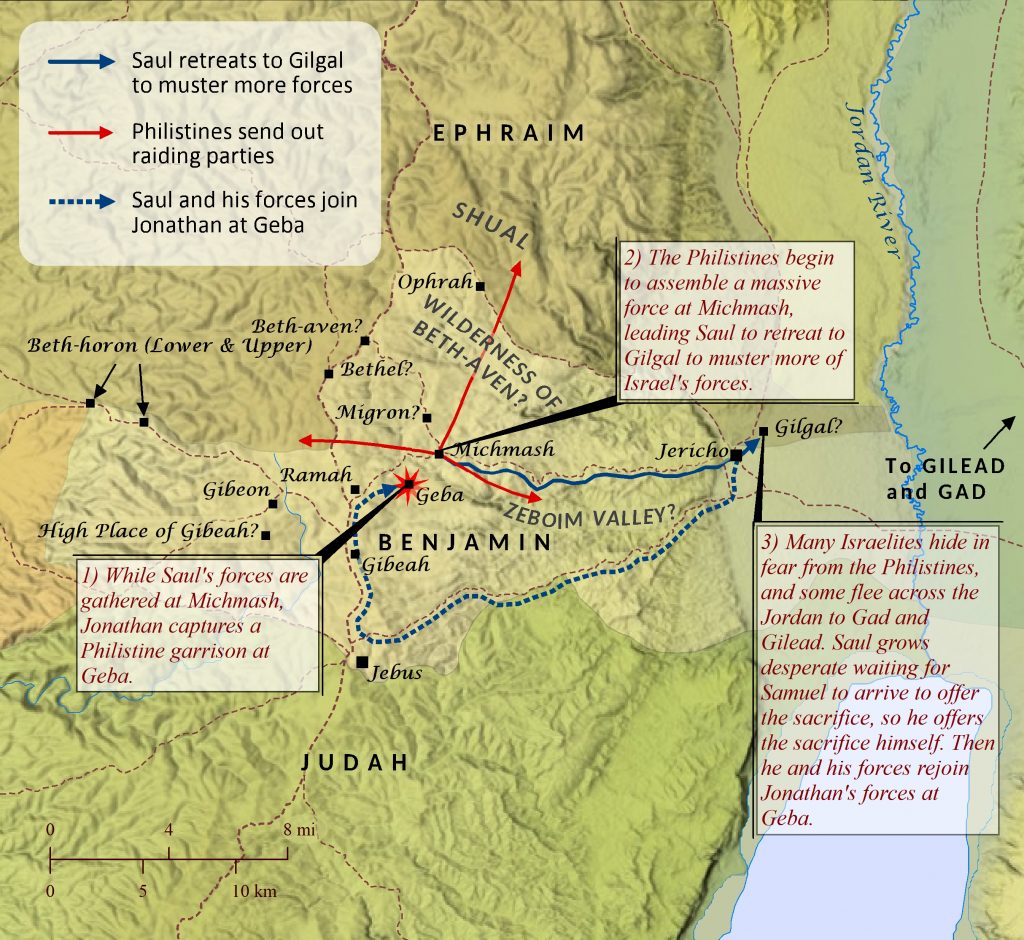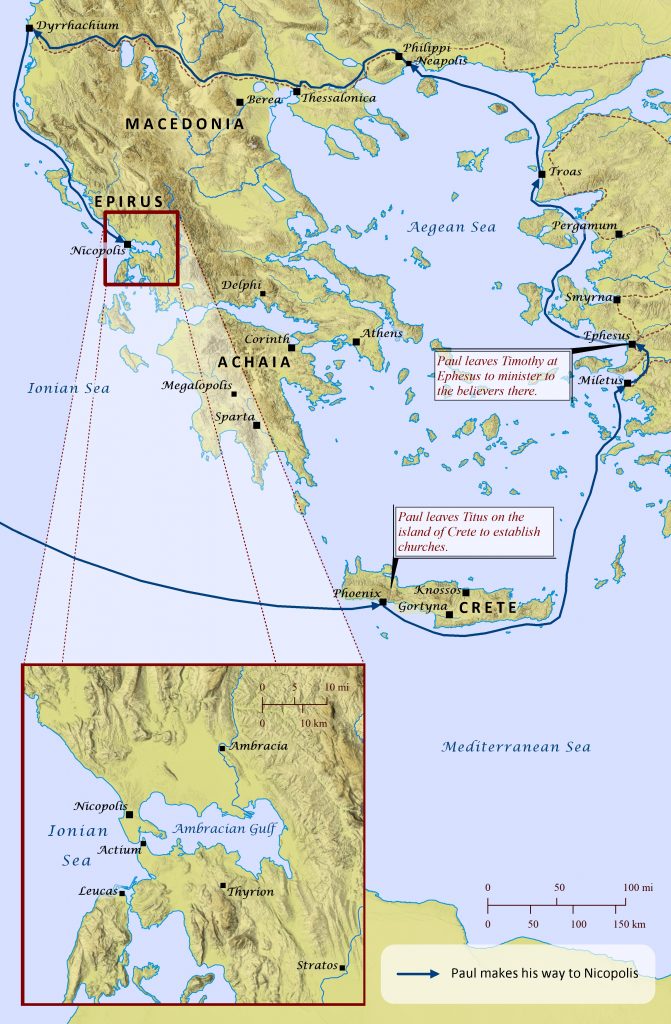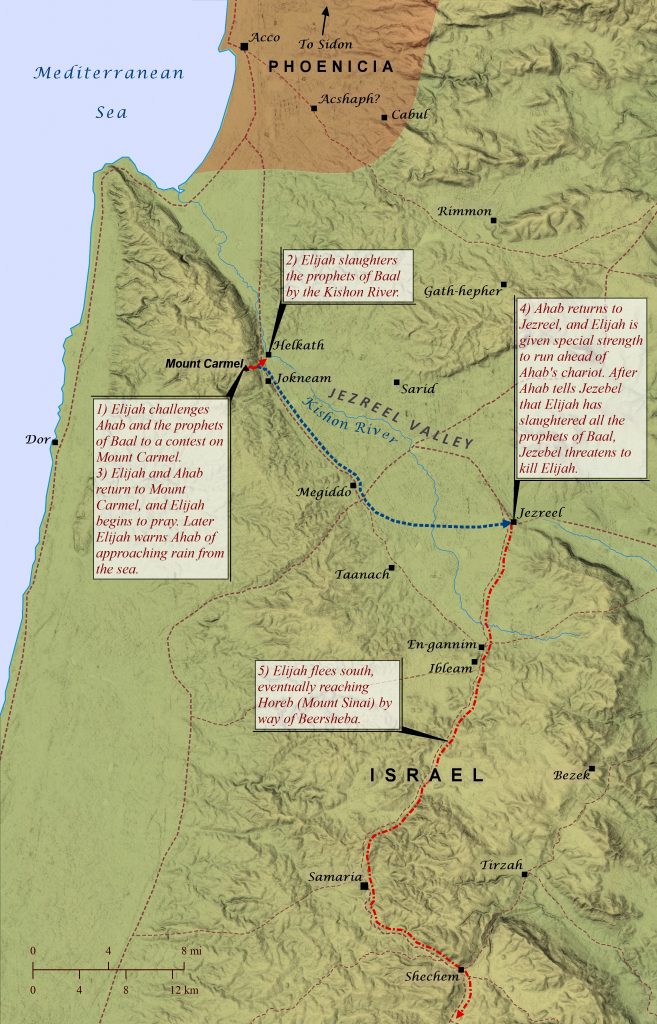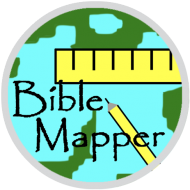1 Samuel 13
The story of the Philistines’ advance into the central hill country of Israel underscores the likely reason why many Israelites demanded a king to rule over them near the end of Samuel’s life (1 Samuel 8). Rather than merely a matter of keeping up with the Joneses (as the issue is often understood based on 1 Samuel 8:5), it is likely that the people were primarily responding to the growing threat of the enemy nations around them (Joshua 13; Judges 1), including the Philistines on the coast. It appears that the Philistines had gained control over the blacksmiths of the land and thereby prevented the Israelites from fashioning metal weapons (1 Samuel 13:19-23). By the time of Saul’s reign, the Philistines had pushed all the way into the central hill country and occupied Geba (which is what is likely intended by “Gibeah of Benjamin” here) in order to control the key pass between Geba and Michmash. Saul and his forces occupied Michmash itself. At some point Saul’s son Jonathan defeated the garrison of Philistines at Geba, but his actions led the Philistines to amass a vast army of chariots, horsemen, and soldiers to capture Michmash. Saul left Michmash and retreated to Gilgal to muster more Israelites to fight against the Philistines, and it is possible that Jonathan remained at Geba across the pass. When the Israelites heard of the Philistines’ actions, many of them became afraid and fled. Some even crossed the Jordan River to the land of Gad and Gilead. At some point Samuel must have instructed Saul to wait seven days for him to come and offer a sacrifice in order to call for God’s blessing on the troops, but Samuel was delayed. This led some of Saul’s men to desert, and Saul grew desperate and offered the sacrifice himself. When Samuel did finally come, he rebuked Saul for offering the sacrifice, and then he left. Saul and his men then left for Geba, apparently to join Jonathan’s forces there. In the meantime, the Philistines at Michmash were sending out raiding parties in three directions: toward Ophrah and the land of Shual, toward the west to Beth-horon, and toward the mountain that looks down upon the Zeboim Valley, likely the lower portion of what is now call the Wadi Suweinit. Thus, the background was set for the heroic actions of Jonathan, who bravely scaled the nearby cliffs with his armor-bearer and attacked the Philistines and inspired Saul’s forces to drive the Philistines from the central hill country (see the recently updated Battle of Michmash map here).

? download hi-res file 🔍 see in TimeGlider
Nicopolis and Its Surroundings
Like a teaser near the end of an epic novel, Paul’s brief, singular mention of his plans to winter in the city of Nicopolis (Titus 3:12) raises as many questions as it answers regarding his travels after his imprisonment in Rome (Acts 28:14-31). Though Scripture doesn’t clearly say, it seems that after Paul left Rome (and perhaps traveled to Spain) he traveled to Crete and left Titus behind on the island to minister there (Titus 1:5). Then he made his way to Ephesus with Timothy so that Timothy could do the same. After this Paul traveled to Macedonia (1 Timothy 1:3). It appears that Paul then traveled to Nicopolis around A.D. 65 and sent a fellow worker back to Crete to visit Titus, and he urged Titus to come to him at Nicopolis, because he planned to spend the winter there. Paul does not indicate why he went to Nicopolis, so the best that one can do is simply speculate as to possible reasons. Years earlier in his letter to the Romans Paul declared that he had proclaimed the gospel “all the way around to Illyricum” (Romans 15:19), so perhaps Paul was now continuing this ministry along the western coast of Greece. Also, Paul would have been over 60 years old by this time and had already suffered shipwreck due to bad weather (Acts 27), so it would not be surprising if this contributed to his decision to minister in Nicopolis through the winter. The city of Nicopolis, meaning “city of victory,” had been established in 29 B.C. by Caesar Augustus to commemorate his decisive naval victory over the forces of Mark Antony and Cleopatra near the town of Actium just south of Nicopolis. Augustus also established the quadrennial Actian Games to celebrate this victory, and even Herod the Great, king of Judea, donated money to adorn Nicopolis (Josephus: Jewish Wars: 1, 2, 11, Jewish Antiquities: XVI, 5, 3-147). Augustus compelled many residents of nearby towns to relocate to his new city, and decades later, around A.D. 67–perhaps just after Paul had visited the city–Emperor Nero visited Nicopolis and participated in the Actian Games. Nicopolis served as a vital shipping port between western Greece and Italy, and it boasted significant commerce and fisheries. The city became the capital of the region and was well endowed with sanctuaries, monuments, baths, theaters, stadiums, gymnasiums, and aqueducts. The city was also home to a colony of Jews, who may have provided Paul with a ready audience to hear his good news about the Messiah.

? download hi-res file 🔍 see in TimeGlider
Borders of the Promised Land
The borders of the Promised Land are described by Moses in Numbers 34 (see also Deuteronomy 1:1-8), and hundreds of years later during the Judean exile in Babylon the prophet Ezekiel essentially repeated this same description as he looked ahead to the restored kingdom of God’s people (Ezekiel 47:13-23). The borders included the land of Phoenicia and Damascus, but the actual allotment of the land by Moses and Joshua (Numbers 32; Deuteronomy 3:1-11; Joshua 13-20) did not encompass these areas. When Moses sent spies to scout out the Promised Land (Numbers 13), their route extended all the way to Lebo-hamath, affirming that this was the full extent of the Promised Land as Moses envisioned it. One area difficulty, however, is the exact extent of the northeastern border according to Numbers 34. It is clear that the border passed from Hazar-enan to the Sea of Galilee, but the locations of Shepham, Riblah, and Ain, which are given as markers along this stretch of the border, are uncertain, and this has led to differing opinions regarding whether the region of Hauran was included in Moses’ description as it was in Ezekiel’s description (Ezekiel 47:18). Omitting the region of Hauran, however, would mean that the border passed through the city of Damascus, but this important city is never mentioned in Numbers 34, and this would also make Moses’ description incongruent with Ezekiel’s description in this respect. Thus it is likely that Moses’ description included the region of Hauran. Also, this author has recently found that Tall Sha`f would make a very viable candidate for the location of the town of Shepham (shown on this map), and this perfectly aligns with a border that encompasses Hauran.

Elijah Challenges Ahab
1 Kings 18-19
The story of Elijah’s contest on Mount Carmel with the prophets of Baal is well known. Sometime earlier, Elijah had warned Ahab that there would no longer be any rain or dew in Israel until he gave the word (1 Kings 17:1), presumably because of Ahab’s rabid promotion of Baal worship throughout Israel (1 Kings 16:29-34). It appears that Ahab may have gained this devotion to Baal worship through his marriage to Jezebel, the daughter of King Ethbaal of the Sidonians, and he even built a temple and an altar to Baal in Samaria. Jezebel herself promoted Baal worship by providing for the needs of 450 prophets of Baal and 400 prophets of Asherah and by killing off many of the prophets of the Lord. During the third year of the drought in Israel, the Lord told Elijah to confront Ahab, and soon after this, rain would return to the land. So Elijah met with Ahab and told him to assemble the people of Israel and the prophets of Baal and Asherah on Mount Carmel, and Ahab did so. Elijah may well have chosen Mount Carmel for this contest due to its proximity to both Phoenicia (the homeland of Jezebel and her Baal worship) and Israel, for the mountain would have represented geographically what was true spiritually among the people of Israel: They were straddling two different opinions about the Lord and Baal. When all were assembled on the mountain, Elijah challenged the people to choose once and for all whether they would serve the Lord or serve Baal. And in order to demonstrate which god was truly able to respond to them, both Elijah and the people were to call upon their god to send down fire to consume the sacrifice, and the god who responded would be the true God. When it was over, Baal had failed to respond, but the Lord had sent down fire that completely consumed the offering, and the people confessed that the Lord is God. Elijah immediately called upon the people to seize all the prophets of Baal, and they took them down the mountain to the Kishon River, where they killed them. Then Elijah instructed Ahab to go back up Mount Carmel, and Elijah went up as well and bowed down to the ground. Eventually he noticed a little cloud rising over the Mediterranean Sea to the west, and he sent his servant to tell Ahab to take his chariot and leave in order to escape the approaching storm. Ahab did so, and the Lord granted Elijah special strength to run ahead of Ahab’s chariot all the way to Jezreel. There Ahab told Jezebel that Elijah had slaughtered all the prophets of Baal, and she vowed to kill Elijah by the next day. So Elijah became afraid and fled for his life, heading south and dropping off his servant along the way at Beersheba. Then he went a day’s journey into the wilderness and began to despair under a solitary broom tree. But the angel of the Lord appeared to him and granted him food and strength, and Elijah traveled forty days and forty nights to Horeb, which is called Mount Sinai elsewhere in Scripture.

Rainfall in the Ancient Near East
Throughout biblical history, one of the most tangible demonstrations of the Lord’s goodness to his people is seen in his provision of rain (Leviticus 26:4; Deuteronomy 11:11-17; 28:12; 1 Samuel 12:17-18; 1 Kings 8:35-36; 2 Chronicles 6:26-27; 7:13; Ezra 10:9; Job 5:10; 37:6; Psalm 68:9; 135:7; 147:8; Isaiah 5:6; 44:3; Jeremiah 3:3; 5:24; 10:13; 14:4-22; 51:16; Ezekiel 34:26; Hosea 6:3; 10:12; Joel 2:23; Amos 4:7; Zechariah 10:1; 14:17; Matthew 5:45; Acts 14:17; James 5:7). In numerous passages of Scripture, the Lord is said to be the giver of rain, and rain was a sign of his blessing and favor, for with it came abundant harvests and plentiful drinking water. Conversely, rain could also be withheld as a sign of God’s displeasure with sin, leading to poor harvests and dwindling drinking water. Israel’s rainy season lasts from October until May, with the heaviest rains occurring in December and January. The summer months, from June until September, see almost no rain. The beginning of the rainy season in October is referred to in Scripture as the early rains, and farmers are eager for their arrival in order to begin plowing and planting. Then the rains continue heavily through the winter. Even more important, however, are what Scripture calls the latter rains. These final rains of the season can significantly increase yields–or bitterly destroy them–for they provide critical water necessary during the hottest portion of the growing season. Northern Galilee enjoys the most plentiful rainfall in Israel, with annual totals of about 660 mm, while the lower Jordan Valley and much of southern Israel are essentially desert lands, receiving a scant 16-22 mm of rain each year.
January:

July:

Annual Rainfall (animation):
Data source: Fick, S.E. and R.J. Hijmans, 2017. WorldClim 2: new 1km spatial resolution climate surfaces for global land areas. International Journal of Climatology 37 (12): 4302-4315.
